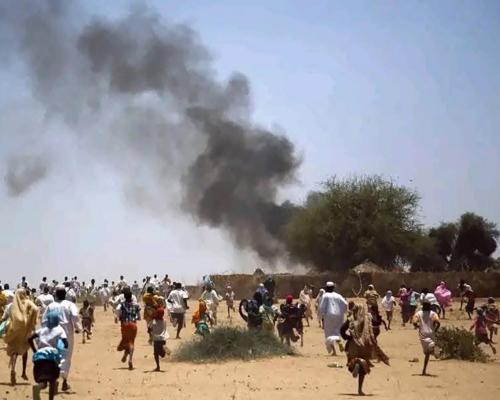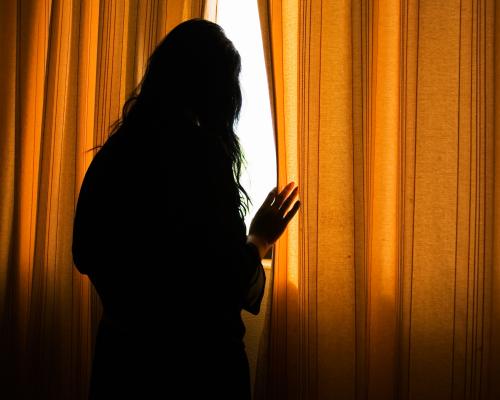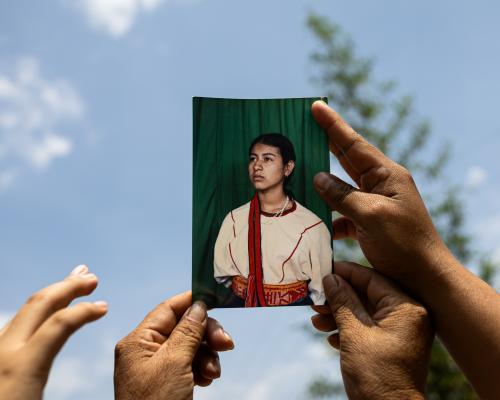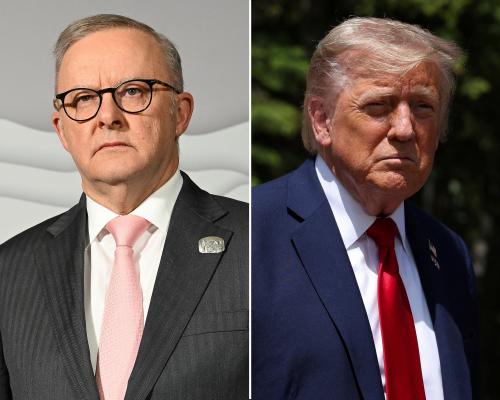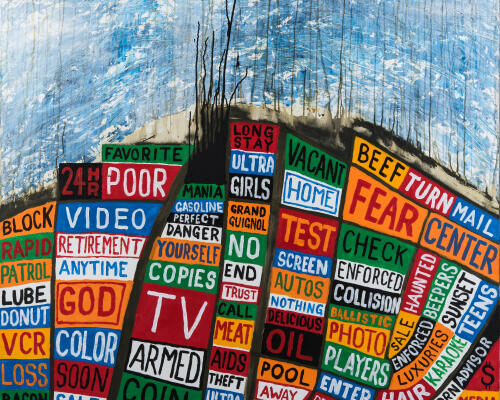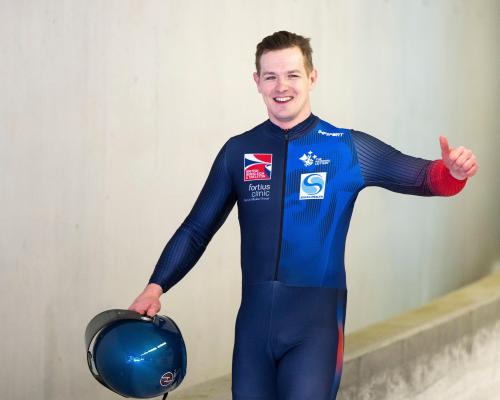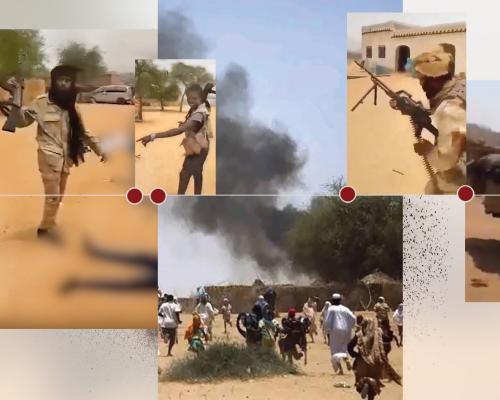
Friday, 11 April 2025
Zamzam Camp, Sudan
At just 22 years old, nurse Hanadi Dawood was an expert in the myriad ways poverty could kill. She knew straight away if a child would last the day; you learn such skills in a place where an infant dies every two hours.
Hanadi ran a small health centre in Zamzam, a sprawling displacement camp in Sudan’s Darfur region, the heart of the world’s largest humanitarian catastrophe.
Her clinic was already busy before breakfast on 11 April. But there was every chance it would get a lot busier. Outside Zamzam, the notorious Rapid Support Forces paramilitary group was massing on three sides, preparing for a possible ground assault.
Some believed the RSF might hold off. Even for a group accused of genocide, Zamzam, they felt, was too soft a target. Its 500,000 residents – predominantly women and children – were virtually defenceless. They were also starving to death.
“Inside Zamzam you’d find one of – if not the – most vulnerable populations on the planet,” says a UN war crimes investigator, requesting anonymity.
Even so, soon after 8am heavy artillery jolted Zamzam. Drones buzzed above. The offensive had begun.
9:30am
Zamzam Camp, Sudan
Attacking on multiple fronts, RSF units breached the camp’s defensive berm.
Near its southern entrance, up to 50 teenage girls sat staring at their phones. Witnesses saw them being bundled into RSF pickup trucks, and driven away. None have been seen since.
Two hundred metres east, 30 RSF pickups entered Ahmadai neighbourhood. Sixty homes belonging to the ethnic Zaghawa tribe were set ablaze. Women were shot as they fled. Six stayed, and burned alive as a consequence.
Five minutes north of Ahmadai, Fatima Bakhit was lying beside her husband, two sons and her uncle, who was blind. Through a fence, the pregnant 25-year-old could peer into the courtyard of Zamzam’s last functioning international clinic, run by Relief International.
11am
Zamzam Camp, Sudan
Four RSF Toyota Hiluxes smashed through the gate to the clinic’s compound. Bakhit watched the medics scramble into two foxholes, the subterranean hideaways residents had dug to survive artillery attacks. Five staff squeezed inside one, four into the other.
“Come out, falangayat [slaves]!” shouted a fighter. A doctor, injured by shelling, emerged. He was shot in the stomach and tumbled back into the foxhole, wounded but alive. Two more shots. “The others were told to lie on their backs. They were killed,” says Hafiza*, another witness.
The occupants of the second foxhole were lined up at gunpoint. They too were executed.
Bakhit’s husband was shot dead. More gunfire followed. Her five-year-old son was struck in the back. “Parts of his body fell in my hand,” says Bakhit.
Her other son, aged three, crawled towards her, spattered red with the blood of his dead brother. Bakhit was shot in the right leg and hand. “Hey! I told you not to shoot women and children,” yelled an RSF officer.
He turned to Bakhit. “Your men are falangayat. Stand up!” Bakhit’s blind uncle stumbled. He was killed.
11.30am
Zamzam Camp, Sudan
The RSF entered the Sheikh Farah Quranic school next door to the clinic. It was packed with students and residents seeking shelter. Among them was Sumaya Adam. “We hid, but the attackers dragged the men out.”
Bakhit watched at least 15 children and men being led outside. “They got them standing in line and shot them all dead.”
The killing spree, by turns methodical and frenzied, would last another 70 hours.
***
Until now, what unfolded at Zamzam has largely remained a mystery: many of those who witnessed the atrocities were killed. However, testimony from scores of survivors along with intelligence and UN sources offers an intricate insight into one of the most shocking episodes of Sudan’s worsening war.
Pieced together, the accounts portray an ethnic slaughter of such magnitude that the Zamzam attack is likely to have been the second biggest war crime of Sudan’s catastrophic conflict, behind a similar massacre in West Darfur nearly two years earlier.
Official estimates indicate up to 400 people were killed in Zamzam. A committee set up to investigate the true number has so far identified more than 1,500 deaths. Committee member Mohammed Sharif says the final figure will be significantly higher: hundreds are yet to be accounted for.
A Darfur atrocity expert who has interviewed scores of Zamzam survivors is “certain” more than 2,000 died.
But the RSF wanted one resident dead more than any other. From the start, paramilitaries identified Hanadi as a priority target. Senior RSF figures were incensed by footage of the young nurse beseeching Zamzam’s residents to stand their ground.
An extraordinary plot involving undercover agents, bribes and plain-clothed assassins had been hatched to silence her.
“They hate women,” said Manahel, a friend. “Especially ones that stand up to them.”
12.15pm
London, UK
At about the moment that the staff at Relief International were executed, the Foreign, Commonwealth and Development Office (FCDO) forwarded details of a press briefing about a forthcoming conference.
In four days’ time, on 15 April, nearby Lancaster House would host a global summit aimed at bringing peace to Sudan. The date was seared on the Sudanese psyche: the second anniversary of the war between the military and RSF that had shattered their country.
The briefing made no reference to the nightmare evolving in Zamzam. Yet real-time updates were already provoking panic among Sudan’s diaspora.
UK officials began receiving “atrocity alerts”. Two days before the Zamzam offensive, sources say the UN security council was briefed that a large-scale assault on the camp was imminent.
A month earlier, analysts from Yale University had told the council in person that Zamzam was at risk, one of five face-to-face warnings it shared in 2025.
Nathaniel Raymond, at Yale’s Humanitarian Research Lab, says: “We made concerted efforts to warn the international community that a full-scale assault on Zamzam was both imminent and inevitable.”
Less than 24 hours before the attack, sources say FCDO officials were taken aside by concerned experts at an event at the Chatham House research institute in London and told of fears of an impending ethnic massacre at Zamzam.
An attack on Sudan’s largest displacement camp was the scenario everybody dreaded. Two decades earlier, it had been conceived as a haven for the ethnic African tribes being slaughtered by Arab militias – the same militias that would become the RSF.
Few Darfuri families had avoided the genocidal violence that killed up to 300,000. Born the year the genocide began, Hanadi chose nursing because of the suffering she saw as a child.
The violence has rarely subsided since. Zamzam expanded with each spasm of fighting. Now 4 miles (7km) long, its proportions did not prevent it being surrounded by the RSF. Besieged since June 2024, food was beyond scarce. Residents were forced to eat leaves to survive. In August that year, famine was declared.
“There was a moral obligation for the London conference to break the siege,” says a UN source.
There was, however, a complication. Among the 20 countries invited to the conference was the UAE, one of the west’s most coveted economic partners.
Although the UAE “firmly rejects any claims of providing arms or military equipment” to the RSF, allegations to the contrary are widely documented. Critics allege it is plausible that weaponry linked to the Gulf state was used at Zamzam. The UAE says the claims are unfounded.
Campaigners, though, sensed a unique opportunity. The timing of the assault, on the eve of the London conference, would surely persuade the UK foreign secretary, David Lammy, to call out the UAE.
“Lammy could have used his leverage to tell his Emirati counterpart to cancel the outrageous attack on a displacement camp: ‘If you don’t, you are not invited to London,’” says a UN expert.
Such a warning would have had merit. Sources reveal Emirati officials are in “constant contact” with the RSF’s leader, Gen Mohamed Hamdan Dagalo, known as Hemedti, among others. Sources, in fact, reveal the UAE had already moved to prevent another massacre.
Sources say in June 2024, Abu Dhabi called Hemedti and “told him to stop” a planned assault on El Fasher, after the UN security council introduced a resolution demanding the RSF cease fighting around Zamzam and El Fasher, the neighbouring city.
No attack happened.
Friday, 11 April
Zamzam Camp, Sudan
In Sudan, the RSF continued to push deeper into Zamzam. House to house searches were carried out. Occupants were summarily executed. Tayseer Abdalla saw two of her aunts and their young daughters killed inside their home near the central market.
Mariam watched the militia enter her sister’s house. “They dragged her out and killed her. They slaughtered us like animals,” she says.
Ruqayyah and her family were leaving when the RSF entered their home. Wordlessly, they opened fire. Ruqayyah was able to limp away. Three others were left to die.
Meanwhile, across south Zamzam, RSF fighters offered bribes for clues to Hanadi’s whereabouts. “They were offering huge amounts,” says Ismail Idris, a relative who lives in the British town of Reading.
Kaltouma, another camp resident, describes the fighters arriving at her door. “They were shouting: ‘Where is she? Where is she?’”
For all the efforts to locate her, Hanadi was often directly in front of them. “She was present on the frontlines, treating, bandaging,” says friend Mohamed Afandy.
The casualties mounted. Defended by a ragtag mix of volunteer resistance units and joint forces – whose remit was to protect civilians – the camp was hopelessly outgunned and outnumbered.
About 200 RSF pickups had attacked Zamzam, seven times the number defending it. By midday, the RSF had crossed the B26 highway, entering the main camp.
A call had gone out for civilians to defend Zamzam. “Hanadi was among the first to answer,” says Muhammad Effendi, a resident.
Hanadi headed to the frontline armed with a modest kitchen knife. Up against hi-tech drones and guided bombs, Hanadi’s father, Juma, says her unit repelled at least one attack.
By early afternoon, Hanadi’s unit was pinned down near the central market. Witnesses describe the nurse laying down her knife to tend to the wounded.
Mohammed Sharif, 27, ran past her position under ferocious fire. “I saw her saving injured people, giving them medicine.”
Hope rested with a sizeable Sudanese military garrison seven miles away in El Fasher. If soldiers were sent, Zamzam would be saved.
“We were waiting for support from El Fasher but didn’t get it. We still don’t know why,” says Mohamed Adam, a teacher.
The central market was not the only place under pressure. Mustafa Bora saw RSF fighters heading for the camp’s community kitchen.
Bora sprinted there, imploring everyone to evacuate. Hasanat Musa – seven months pregnant – and her friend, Nana Idris, refused to budge.
“Why are you cooking for slaves?” asked fighters as they stormed the kitchen, smashing pots. Musa’s late-stage pregnancy offered no protection. She and Idris were executed.
The attackers closed in on Hanadi’s new position: a makeshift health centre north of the market. Hisham Mohamed was fighting alongside her. “She told us: ‘Die with honour. I will be here until the end.’”
Hanadi may not have noticed the men approaching. Only when alongside her did they reveal their weapons. She was shot at close range.
“Their operatives infiltrated the camp disguised in civilian clothing to carry out her assassination,” says Juma.
Chaotic footage shows her being carried by friends to another rudimentary clinic. A soundtrack of gunfire is constant.
By now, much of Zamzam was hurrying north. Shells fell on fleeing families. RSF snipers climbed trees, picking them off.
Mariam witnessed children flattened by a shell as they fled. “Nobody will ever bury them,” she says.
Others described leaping over body parts. Bleeding children lay waiting for help that never came.
Hundreds hid underground in cramped, sweltering foxholes. “They were quickly filled with women and children,” says one witness, Adouma Ali.
RSF death squads combed the area. Anyone found in a foxhole was shot.
Further south, Bakhit lay frozen beside her dead husband and child. At 3pm a neighbour attempted to reach her but was shot in the hip.
6.30pm
Darkness fell. The RSF retreated. “Suddenly it was quiet. People emerged from foxholes, shellshocked,” says Ali. As the cacophony of gunfire subsided, children could be heard crying in the dark.
Next, the scraping of shovels as bodies were placed in shallow graves. Bakhit laid her five-year-old son and husband in an enlarged foxhole.
In Zamzam’s southern neighbourhoods, the night brought terror. Fighters wandered devastated streets, looking for women to abduct. In Hamaday and Karaba districts, they began raping.
Elsewhere, residents headed towards Saloma, Zamzam’s northern neighbourhood. Many passed the makeshift clinic where volunteers were battling to save Hanadi.
Back in London, as night fell, the mood among humanitarians was febrile. Attempts to cajole FCDO officials into making a statement on Zamzam ahead of the conference had foundered. “Everybody was raging, asking: ‘Where’s Lammy?’” recalls a prominent human rights expert.
They could not even pressure Sudanese diplomats attending the conference: none had been invited.
Details of the atrocities, delivered to western policymakers, were politely dismissed.
“Evidence of genocide was met with: ‘Thank you for sharing. Keep us updated,’” says a prominent humanitarian.
Although the UK is “penholder” on Sudan – meaning it leads the UN security council’s activities on Africa’s third-largest country – nothing happened.
Many felt the timing of the offensive before the conference was deliberate. “It was beyond provocative. The RSF – and its alleged backers, the UAE – were saying: “Go on, let’s see what you can do,” says the UN investigator.
Saturday, 12 April
8am
Zamzam
Zamzam shuddered again under a ferocious artillery bombardment. One resident counted 250 shells. Tens of thousands of residents began moving towards Saloma.
Leaving her home in Jafalo, Nafisa encountered devastation. “I saw 18 dead bodies, including a child killed by shelling.”
Drones targeted main roads. At 11am, Bora saw a girl staggering around Labado neighbourhood. Shrapnel had speared her face. She had lost an eye.
Qismah, an aid worker, watched adolescent fighters targeting whoever they came across. “They didn’t even try to communicate. They just shot at anyone.”
Across Zamzam, a huge game of cat and mouse unfolded.
Jamal, a health worker, and his family were near the almost deserted Médecins Sans Frontières (MSF) hospital when RSF fighters approached.
Jamal ran into a house, joining 50 other people hiding inside alongside a flock of sheep. He peered into the street. Residents were being dragged outside. “I saw them kill six civilians; five young men and someone over 80 years old.”
The RSF came closer. More shots reverberated outside. The door swung open.
“They entered, saw the sheep, took them and forgot who was in the house. But they were killing anyone, even children. My cousin was killed that way,” says Jamal.
Some people headed east, seeking refuge in a nearby valley. Halima and her three children ran there, pursued by RSF pickups. They had no chance.
“Before they spoke, they shot my 16-year-old son in the head. I attacked the person who fired, but four men grabbed me: two by the legs, two by the hands. The man who killed my son raped me,” says Halima.
Then they raped her teenage daughters. “I could hear their screams, especially my youngest, who was 13. After an hour and a half, [the RSF] left.”
Halima laid clothes over her dead son. She carried her youngest daughter, who could not stand, to Saloma.
Some crimes were thwarted by women who, inspired by Hanadi, had joined self-defence units. Fatima Ramadan was being pursued by the RSF when self-defence recruits “no older than girls” intervened. “The girls gave us advice and guidance on how to get out.”
By mid afternoon, the central market was ablaze. Bleaker news followed: attempts to save Hanadi had proved futile. At about 3pm, the nurse was buried in a secret location to prevent the RSF desecrating her body.
Ammunition, fuel and food supplies were perilously low. Joint forces commanders told relatives they were contemplating a full withdrawal.
Reports began to surface of children being executed. In one account, RSF had converged on a straw hut in west Zamzam. Several infants were hidden inside. Fighters stood in the doorway and “opened fire on the children”.
Nightfall prompted a procession of people to move silently towards Saloma. The joint forces retreated to El Fasher.
London
The failure of the Sudanese army to help Zamzam hurt. One theory suggests the military sat back and allowed the RSF to rampage, assuming the politicians gathering in London would have little choice but to censure the militia and its Gulf ally.
The weekend began with the firm expectation Lammy would issue an early, robust statement on Zamzam. WhatsApp exchanges between atrocity experts and FCDO officials urged the foreign secretary to act.
Although officials “acknowledged” the dire situation in Darfur, for the first time humanitarians began to think that they might do nothing about it.
“Zamzam obviously framed the conference. Were they deliberately trying to ignore it?” says a source in frequent contact with Lammy’s advisers.
As the hours ticked by, and the litany of RSF brutalities grew ever longer, a decision was seemingly made by the UK government to say nothing. No emergency meeting was convened; no face-to-face with groups collating evidence of war crimes from Zamzam.
Repeatedly, officials were told they risked ignoring possible genocide. Messages between advisers to the UN security council compared the attack to Srebenica, where more than 8,000 Bosniak Muslim men and boys were slaughtered by Bosnian Serb forces in 1995.
Did Lammy pressure his Emirati counterpart over Zamzam? Did he even raise Zamzam? The FCDO declined to comment.
“Ultimately – by pen and by sword – the RSF was doing its thing in Zamzam while the UAE did its thing in London. Both components were working to keep a genocidal project going,” says a prominent human rights analyst.
Tempers flared. “At one point officials felt the burgeoning atrocity wasn’t worth contacting Lammy for,” the analyst claims.
The UAE told the Guardian: “We categorically reject any claims of providing any form of support to either warring party since the onset of the civil war.”
3pm
London
At a time delayed for colleagues in the US, campaigners met online to strategise how to challenge the inertia. Journalists received details of “genocidal” violence.
Darkness came with no response from the UK. Similarly, no emergency UN security council meeting had been called.
Those monitoring the atrocities in Zamzam from London were consumed with helplessness. “Help! This is hell!” read one WhatsApp message.
7.51pm
London
Then, something: Lammy sent a tweet. “Shocking reports” from Darfur, he wrote, giving impetus to the impending conference. “All sides must commit to the protection of civilians.”
Sunday, 13 April
Zamzam
Daybreak saw thousands huddled around Saloma Square, northern Zamzam. Hundreds more squeezed inside the grand mosque for protection.
Shortly after 8am, RSF fighters flooded the square. Those sheltering inside the mosque were ordered out. “The RSF began dividing people based on their ethnic groups and physical strength. They started with young men,” says Ibrahim.
The men were told to stand in line. It is not known how many were massacred. “A large number were executed by gunfire,” says Ibrahim.
Elderly men and women were split into groups. Individuals identified as Zaghawa and linked to the joint forces were, he says, brutally beaten.
Community leaders and teachers were humiliated. Unrestrained violence was reserved for another young nurse, called Mihrab. Upon finding surgical gloves in her bag, she was beaten repeatedly for treating falanqayat.
Women and children, say witnesses, were separated based on physicality; those deemed sufficiently sturdy were forced to walk livestock to Kabkabiya, 105 miles away.
Testimony then describes eight shells thumping into Saloma Square. Fighters charged the crowd from east and west.
Amid the pandemonium, Bakhit lost her three-year-old. Panicking, she limped south to find him. Bodies littered the landscape.
“Vehicles smelt, bodies were still inside,” says Bakhit. “An RSF commander said: ‘Throw those bodies in the khor [creek].’”
Satellite images confirm widespread destruction. As Zamzam burned, RSF units started shelling El Fasher.
1pm
Zamzam
The camp was now in full retreat. At 1.45pm the Sudanese American Physicians Association received a message from colleagues in Darfur. “Zamzam under the control of the RSF,” it read.
Women trapped in the camp became increasingly vulnerable. At least eight were raped that afternoon. Others were abducted. Eleven were reportedly trafficked 19 miles south. Families were asked to pay a ransom equivalent to £6,000 for their release.
Back in Saloma, gigantic crowds were hemmed in by the RSF. “Severe shortages of food and water led to the deaths of many children,” says Jamal Abdullah, a teacher.
When eventually allowed to leave, more than 400,000 people fled Zamzam. Tens of thousands walked 30 miles to Tawila. Among them was Hanadi’s family.
It was a hellish journey. Women and girls were raped at checkpoints.
Men walked away from the road to avoid execution. But the main killer was starvation or thirst. Sources estimate hundreds may have died making the journey.
Ethnic prejudices underscored the enmity. Marchers were asked in Zaghawa: “How are you?” Anyone who responded was beaten.
Bakhit, unable to find her toddler in Zamzam, joined the throng to Tawila. She felt numb. “I had lost my husband, my children. I felt nothing. Not even hunger.”
Multiple accounts, though, detail extraordinary acts of kindness: thousands of children and elderly people were carried by strangers.
The aftermath
By most metrics the London conference on Sudan flopped, torpedoed by bickering between the Emiratis and opposing Arab states. The concluding conference statement ignored Darfur’s horror. Zamzam was not even mentioned.
“It was like they pretended it never happened,” says a UN source. UK officials say the conference “substantively advanced international coherence” on Sudan.
Lammy did not dedicate 15 April to Sudan, finding time to secretly meet his Israeli counterpart. The FCDO would not say for how long, why or where the meeting occurred.
“Why wasn’t every diary slot that day devoted to civilian protection in Sudan?” says a diplomat.
The conference also sidelined the most important group in Sudan: its women.
Hala Al-Karib of the Strategic Initiative for Women in the Horn of Africa says: “Sudanese women form the backbone of their communities. They smuggle food and medicine, risking their lives. Yet we have no presence in policy and political settings.”
Abdallah Abugarda, of the UK’s Darfur Diaspora Association, believes Zamzam proves the UK chose the Emirates’ economic muscle over human rights.
Of 30,000 Darfuris in his organisation, he says 4,500 know a friend or relative killed in the attack. Leeds-based Suleiman Yousif lost eight family members. “They were murdered together in one location,” he says.
On 17 April, as the enormity of the massacre started to become clear, the UN security council condemned “repeated attacks” on Zamzam.
A week later, Lammy issued a statement, saying the attack carried the “hallmarks of ethnic cleansing”. He has released no official statement on Sudan since then.
An FCDO spokesperson, referring to the Zamzam attacks as “abhorrent”, said: “The UK and foreign secretary are at the forefront of efforts to keep the conflict on the international agenda.”
Already the slaughter feels like a footnote. An all-party parliamentary meeting on Sudan after the offensive provoked dismay. “None of the speakers mentioned what happened in Zamzam,” says Abugardh.
A subsequent request to hold a special session on the attack was, he claims, rejected.
Meanwhile, an unpublished UN report on atrocities in Sudan contains, say sources, “half a line reference to what occurred at Zamzam”.
Thirty-seven days after Zamzam fell, the UK declared its desire for a trade deal with the Emirates.
***
Back in Darfur, Hanadi is still celebrated. Her killers, however, will probably never face justice. Her former home stands largely deserted: Hanadi’s family are split between Tawila, Chad and their original North Darfur village.
UN investigators believe such “deliberate displacement” was the motive for the attack. Others believe Zamzam was ransacked so the RSF could pay fighters. Residents are adamant the attackers wanted to “exterminate” them.
Sporadically, cheering news comes from Darfur. After 18 days trawling Tawila for her toddler, a chance encounter with an injured woman revealed Bakhit’s son was safe, 12 miles away in Shagra. They were reunited in May.
But another ethnic slaughter is looming. El Fasher – with a population of over a million – is surrounded, starving and under attack from the RSF.
As the fighting intensifies, new heroes like Hanadi will inevitably emerge. They, too, will be buried in secret graves, legends in a war with no end.
* To protect them, most eyewitnesses interviewed for this piece have been identified by their first name only or a pseudonym

